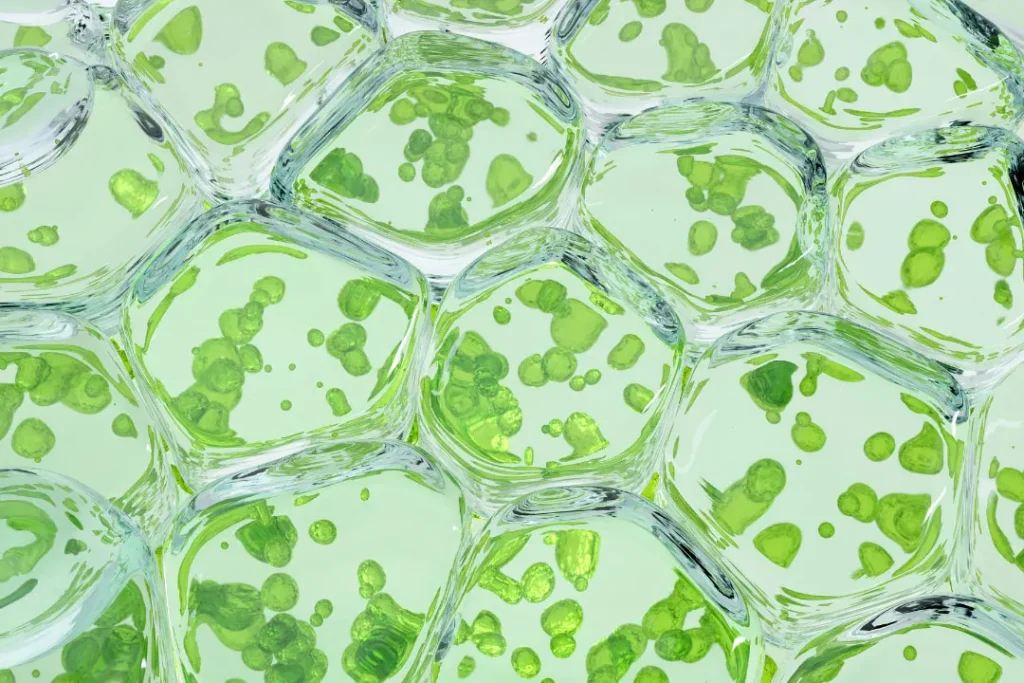Chlorophyll is a green pigment that is fundamental to the process of photosynthesis in plants. It has recently attracted a lot of attention owing to the diverse array of possible health advantages that it offers. It has the exciting possibility of improving our health and well-being, and we can now take it as a natural supplement.
Chlorophyll is as tiny as a molecule, and yet it has a complicated structure that consists of a porphyrin ring. This ring is also coupled with a magnesium atom at its core. The magnesium atom is the center of the porphyrin ring, which consists of four atoms of nitrogen around it. Both chlorophyll A and chlorophyll B are present in the atom , and they differentiate from one another based on the chemical compounds in their side chains.
You May Also Like:
Finding The Best Alpha GPC Supplement
Neurotransmitter Balance Supplement vs Brilliance
Chlorophyll: Benefits, Dosage, Side Effects, Drug Interactions, and Other Important Information is an original (NootropicsPlanet) article.
The Nature of Chlorophyll
The porphyrin ring that chlorophyll is coupled with has a magnesium atom in the middle of its structure. The magnesium atom is surrounded by four nitrogen atoms in the porphyrin ring. Depending on the makeup of their side chains, the two kinds of chlorophyll, A and B, may be found inside . The methyl group (-CH3) in chlorophyll A is different from the aldehyde group (-CHO) in chlorophyll B.
This is because the structure of chlorophyll allows it to play a key part in photosynthesis, which transforms light energy into chemical energy. As a result, this forms the foundation for our life on Earth.
Health Benefits of Chlorophyll
Chlorophyll has been proven to improve our health in a variety of different ways, including weight management, and supporting healthy blood flow, it can be used as a natural deodorizer, and it adheres to antioxidant properties.
Chlorophyll is structurally similar to hemoglobin, the molecule that is responsible for delivering oxygen throughout our blood circulation. This is important to our blood health. Research has shown that because of this resemblance, chlorophyll can in replenishing and raising the quantities of oxygen in our blood.
Chlorophyll has been utilized for a very long time as a natural deodorizer and detoxifier. Scientifically, it binds to odor-causing substances and inhibits their absorption, which results in a reduction of both body odor and feces odor.
Chlorophyll and its derivatives have many antioxidant capabilities. They have the ability to destroy dangerous toxins in our body, which can reduce the effects of oxidative stress. Oxidative stress is linked to aging, as well as a variety of other ailments.
By taking chlorophyll as a supplement, it can help you manage your weight by modifying hunger and lowering the risk of weight gain. This is according to research that was conducted on animals.

Chemistry of Chlorophyll
A porphyrin ring is the fundamental component of chlorophyll. This is a huge cyclic structure that is composed of four pyrrole subunits that are joined to one another by methine bridges (=CH-). An ion of magnesium can be found in the middle of this ring. The core atom of chlorophyll contains magnesium, while heme’s central atom is iron. Chlorophyll’s structure is strikingly similar to that of heme, the oxygen-carrying component of hemoglobin in our blood. The important distinction is that chlorophyll is found in plants.
The molecule of chlorophyll has a lengthy phytol chain linked to it, which helps anchor it to the thylakoid membrane in the chloroplasts of plant cells. This chain is bonded to the chlorophyll molecule. Both chlorophyll A and chlorophyll B are the primary types of this pigment. These two types of chlorophyll are distinguished from one another by the side chain that is connected to the third carbon in the porphyrin ring. Chlorophyll A has a methyl group, while chlorophyll B has a formyl group.

Physical Properties of Chlorophyll
Chlorophyll’s chemical composition and interactions with the tissue in our body are primarily responsible for its wide range of health benefits.
Blood Health: Research into the potential benefits of chlorophyll’s abillities to aid in the development of our red blood cells is similar to its structural resemblance to hemoglobin and its high magnesium concentration. This can improve oxygen delivery within our body.
Organic Deodorizer: Chlorophyll is thought to function as a deodorant by neutralizing volatile sulfur molecules. These are usually to blame for foul breath and other bodily smells that our body produces.
Chlorophyll has antioxidant properties that are the result of the molecule’s capacity to participate in electron transfer pathways. These may also quench reactive oxygen species (ROS) and lessen oxidative stress.
Weight Management: Although the precise process is yet unknown, some research points to chlorophyll as a potential modulator of hormones that control our appetite, which could potentially lessen our hunger pains and increase our feelings of fullness.
In conclusion, the molecular structure of chlorophyll has a significant impact on its physical abilities. . The research that is available points to a variety of possible health benefits from chlorophyll supplements , even if many of these pathways are still being studied. Further study is still required to completely understand these processes and to validate the effectiveness chlorophyll has as a dietary supplement.
Optimal Dosage of Chlorophyll
The ideal chlorophyll dose varies and depends on a number of factors including your age, overall health, and how you intend to use the supplement. Clinical research has examined the health advantages of chlorophyll have made use of a broad dose range. Supplements often suggest taking 100 to 300 mg of chlorophyllin, which is a semi-synthetic combination of sodium copper salts generated from chlorophyll. You should take these daily. . In order to take the dose that will work best for you, you should first consult with a medical professional.
Side Effects of Chlorophyll
Chlorophyll is usually regarded as harmless and has limited reported side effects. However, some people may suffer mild stomach pain, diarrhea, or a color change in their urine or stools after taking this supplement. Because it is a green pigment, it has the potential to cause skin discoloration if it is applied topically or consumed in large amounts. . Even while side effects are normally safe and very transitory, you should still seek medical assistance if you have any symptoms that are persistent or cause you to worry.

Potential Substance Interactions with Chlorophyll
Due to its photoreactivity, chlorophyll has the potential to interact with medications that photosensitize. This means that being exposed to sunshine after consuming chlorophyll might possibly have the effect of amplifying the effects of photosensitizing medicines, which can increase the risk of phototoxic responses.
Responsible Use of Chlorophyll
Although chlorophyll can be used and applied to our body in multiple ways, it is not a cure-all by any stretch of the imagination. A diet that is both well-balanced and abundant in green vegetables is an excellent natural supply of chlorophyll and should serve as the basis for nutritional wellness. Instead of serving as a substitute for a well-balanced diet and active lifestyle, taking a chlorophyll supplement should be seen as an additional method to support your overall health.
It is highly suggested that you speak with a healthcare professional prior to beginning any supplement program, including the use of chlorophyll.
In a nutshell, more research is required due to the distinctive chemistry of chlorophyll and the possible physiological advantages it can provide. It is certain that subsequent studies will shed greater light on its potential uses in improving our health and well-being.
Chlorophyll should be used with the same degree of caution and knowledge required for the use of any other dietary supplement if you want to get the full range of advantages from it while minimizing the possibility of side effects.

Chlorophyll: Conclusion
Although research is still being done on the uses and benefits of taking chlorophyll as a dietary supplement, it is continuing to be proven safe and beneficial when used properly and safely. However, it is very important to remember that it should not be taken as a replacement, but as an additional supplement.
It has very few side effects, but you should still talk to your doctor before using it to make sure it will not cause any other negative side effects specific to your over all health and wellbeing. If you are interested in trying a natural supplement that can be used as a natural deodorant, aid in healthy blood flow, or even help with weight management, this supplement may be right for you!
References:
- The Role of Chlorophyll in Plant Growth. Retrieved From: https://www.frontiersin.org/articles/10.3389/fpls.2018.00476/full
- Chlorophyll derivatives as a visual deodorizer in colostomy patients. Retrieved From: https://jamanetwork.com/journals/jamasurgery/article-abstract/589636
- Chlorophyll Revisited: Anti-inflammatory Activities of Chlorophyll A and Inhibition of Expression of TNF-α Gene by the Same. Retrieved From: https://www.sciencedirect.com/science/article/pii/S0378874112004771
Important Note: The information contained in this article is for general informational purposes only, and should not be construed as health or medical advice, nor is it intended to diagnose, prevent, treat, or cure any disease or health condition. Before embarking on any diet, fitness regimen, or program of nutritional supplementation, it is advisable to consult your healthcare professional in order to determine its safety and probable efficacy in terms of your individual state of health.
Regarding Nutritional Supplements Or Other Non-Prescription Health Products: If any nutritional supplements or other non-prescription health products are mentioned in the foregoing article, any claims or statements made about them have not been evaluated by the U.S. Food and Drug Administration, and such nutritional supplements or other health products are not intended to diagnose, treat, cure, or prevent any disease.


